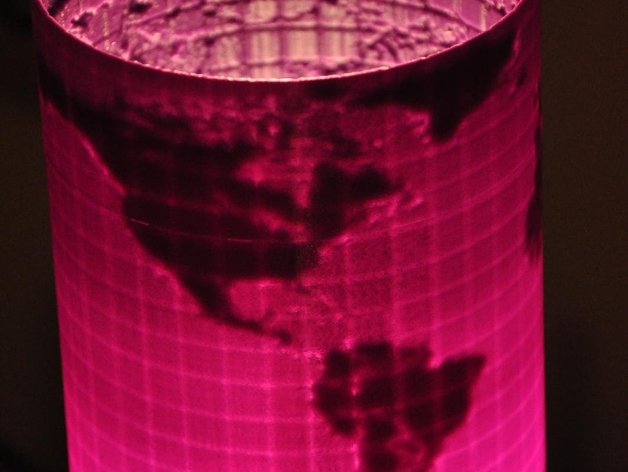
The "World Cup" Lithomap
thingiverse
This is a set of C source tools that generate lithophanes, 3D models made from images that reveal the image when lighted from behind. The tool "lithophane" generates traditional lithophanes in STL format from images in ppm format (use ImageMagick to convert from other formats). The tool "lithocup" generates lithophanes mapped to a cylindrical surface. As an example of the latter, I have included the "World Cup" cylindrical lithophane, which reveals a map of the earth when lighted from the inside. Update: May 10, 2014: Added "margin" option on lithocup to continue cylinder past the edges of the image. Changed lithocup so natural orientation is textured side outward, "xflip" makes it smooth side out. Orientation of cylinder is now upright with respect to the XY plane surface. Update: May 12, 2014: Added "binary" (-b) option on lithocup and lithophane to produce (much smaller!) binary STL files instead of ASCII files. Update: May 26, 2014: Added "margin" (-m) on lithophane to generate a border around the picture, at the same thickness as the thickest part of the lithophane (default 3mm). Update: December 30, 2014: Added "chamfer" (-c) option on lithophane to chamfer the corner borders. This can help alleviate the problem of having the corners lift off the bed during a print. Update: December 30, 2014: Added "lithosphere.c", another version of the lithophane generator, that maps images onto spheres. This program has not been validated with an actual print yet. However, results are correctly manifold. Update: December 20, 2015: Figured out why my pictures were rotated (EXIF data in photo incorrectly handled by the app that I used to rotate it), and posted new ones in the correct orientation. Instructions See the top of the C file for instructions on how to compile. It is only a file-input, file-output tool, so it should compile easily on most systems with a C compiler. Run "lithophane --help" or "lithocup --help" for a list of options. In short: most parameter defaults should work well for most purposes. The input file must be in PPM (portable pixmap) P6 format. You will probably want to use another command-line tool like "ImageMagick" ("convert" command) to convert images from other formats to PPM for input to lithophane and lithocup. The output of both programs is an STL file, ready for slicing. Beware of large outputs that may be too large for a slicer to deal with. Images can be scaled down before inputting to the tools, or use the "--factor " argument to downconvert the image by a factor of . There will, of course, be a tradeoff between the resolution of the lithophane and its file size. The example "World Cup" cylindrical lithophane, which I am calling a "lithocup", was created using an image file of a cylindrical projection of the earth and the command: lithocup -y1.8 -a360 -f2 map_image.ppm world_cup_3.stl The "-y1.8" scales the cylinder height to un-distort the cylindrical map projection somewhat; the "-a360" makes the image a full cylinder (the default is a half-cylinder), and the "-f2" downconverts the image, reducing the resolution (and apparently eliminating Baja California in the process), but also reducing the resulting file size from over 100MB to under 30MB. The C code is provided as open source under the GPL license.
With this file you will be able to print The "World Cup" Lithomap with your 3D printer. Click on the button and save the file on your computer to work, edit or customize your design. You can also find more 3D designs for printers on The "World Cup" Lithomap.
